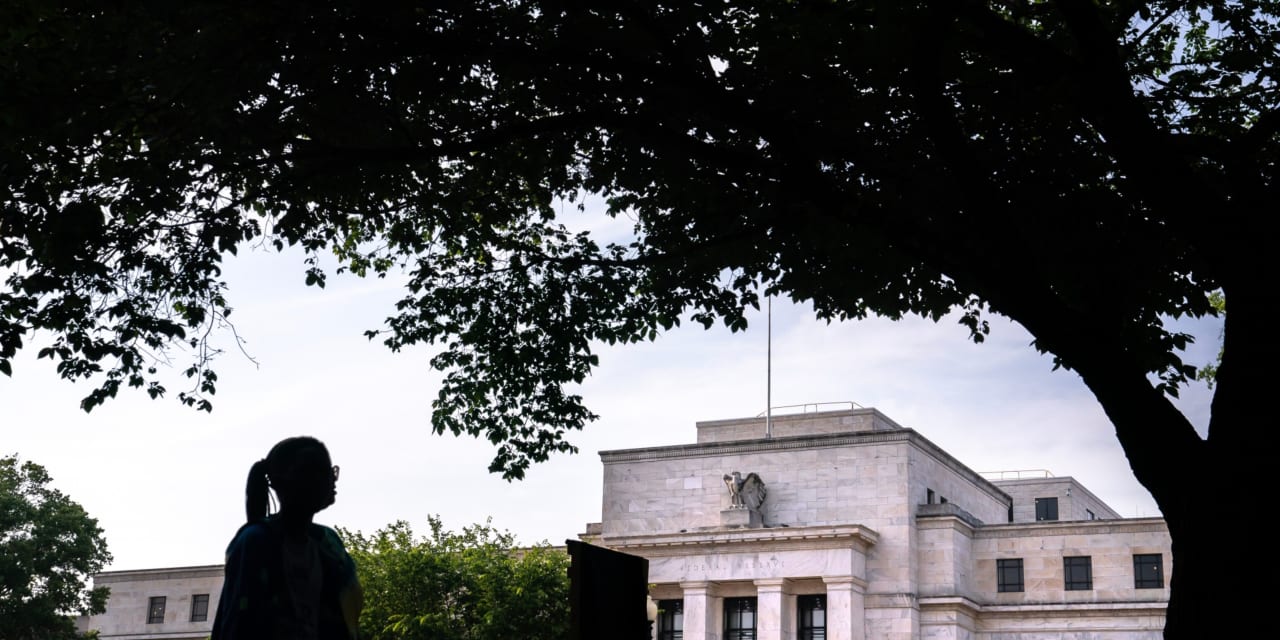Several Federal Reserve officials said at the bank’s September policy meeting that rates were likely “at or near their peak” and suggested that the focus shift to looking more at how long to keep its target for the fed-funds rate at restrictive levels.
The minutes from the Federal Open Market Committee’s Sept. 19-20 meeting, released Wednesday, showed that Fed officials judged that monetary policy had hit a restrictive level and that it “broadly appeared to be restraining the economy as intended.” All agreed that rates should stay at sufficiently restrictive levels for some time to help push inflation back to the Fed’s 2% target.
The fact that officials are now looking at how long rates should stay restrictive is a sign that the current hiking cycle is nearing an end.
“The main takeaway is that the Fed’s focus is shifting away from how much more restrictive monetary policy should be to how long the restrictive stance should be maintained, with a growing emphasis on the economic and inflation impact of tighter financial and credit conditions,” wrote EY Chief Economist Gregory Daco.
The idea that rates will be higher for longer has lately been more in focus, helping to fuel a tightening of financial conditions. At the September meeting, a majority of policy makers said they thought another rate hike was likely to be needed. But conditions have changed.
Yields on 10-year U.S. Treasury notes surged to a 52-week high of 4.8% last week, though they had slipped back to 4.6% Wednesday.
Because the higher yields contribute to tighter financial conditions, a number of officials have noted in recent days that the bond market could do some of the work of cooling the economy for the Fed. That would mean there is less need for additional hikes.
In the latest comments, Fed Gov. Christopher Waller noted Wednesday that he agreed financial markets are tightening up and that trend was going to do some of the work for the Fed. Earlier this week, Lorie Logan, president of the Federal Reserve Bank of Dallas, made the same point.
“Higher term premiums result in higher term interest rates for the same setting of the fed-funds rate, all else equal. Thus, if term premiums rise, they could do some of the work of cooling the economy for us, leaving less need for additional monetary policy tightening to achieve the FOMC’s objectives,” Logan said.
Term premiums are the additional yield fixed-income investors demand to cover the risk of holding longer-dated debt.
Even before bond yields moved higher, at least some FOMC members noted that one economic risk could be that credit conditions might tighten more than expected, according to the minutes.
The minutes are released several weeks after each official FOMC meeting. The latest ones detailed that Fed officials generally feel there was still a “high degree of uncertainty” in regards to the economic outlook for the U.S. even though growth has been solid in recent months. During the September meeting, Fed policy makers chose not to raise the benchmark interest rate, keeping the target for the fed-funds rate at 5.25-5.50%.
A new source of uncertainty is the continuing United Auto Workers strike, Fed officials noted. If the strike should expand significantly, it could pose both an “upside risk to inflation and a downside risk to activity,” according to the minutes.
Most Fed officials also voiced concern over the cost of energy. “A majority of participants pointed to upside risks to inflation from rising energy prices that could undo some of the recent disinflation or to the risk that inflation would prove more persistent than expected,” the minutes say. Gasoline prices rose in September, but have fallen again in recent weeks.
The continuing process of reducing the size of the Fed’s balance sheet was also cited as an important part of the central bank’s effort to achieve its objectives, the minutes said. “Several participants noted that the process of balance sheet runoff could continue for some time, even after the Committee begins to reduce the target range for the federal funds rate.”
Shrinking the balance sheet, or reducing the bank’s holdings of Treasury bonds and other debt, is another central-bank tool that helps push interest rates higher. Letting bonds roll off the Fed’s books could tighten financial conditions regardless of what the bank does with its target for the fed-funds rate.
While all FOMC members agreed that future rate decisions would continue to be based on the “totality of incoming information” and a balancing of potential risks, a few officials did highlight the challenges in assessing economic conditions due to the volatility of some data and large revisions that have been made to it. The latest Bureau of Labor Statistics jobs data, for example, not only reported that the U.S. economy added 336,000 jobs last month, but the agency also revised up both July and August payroll figures by a combined 119,000 more than previously reported.
“Participants expected that the data arriving in coming months would help clarify the extent to which the disinflation process was continuing and labor markets were reaching a better balance between demand and supply,” the minutes noted.
Committee members continued to say that they would proceed carefully and watch incoming economic data releases to determine the extent of additional policy firming that may be appropriate to achieve the 2% inflation target over time.
A data-dependent FOMC that is looking to “proceed carefully” in the near term likely means that the fed-funds rate won’t be changed at the Nov. 1 meeting, wrote Bill Adams, chief economist for Dallas-based Comerica Bank.
Write to Megan Leonhardt at megan.leonhardt@barrons.com
Read the full article here













Leave a Reply